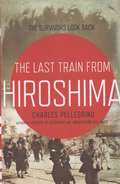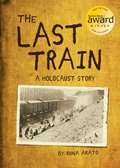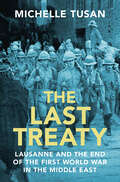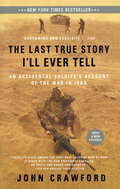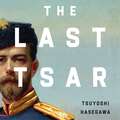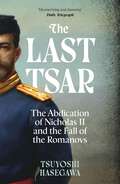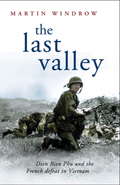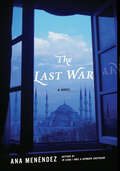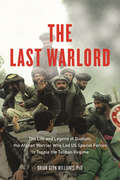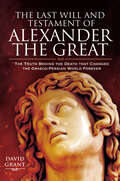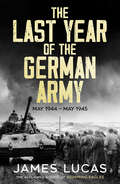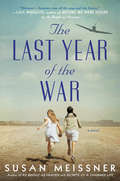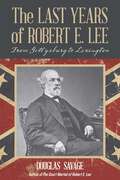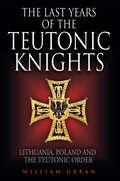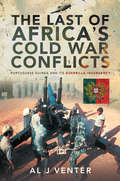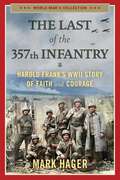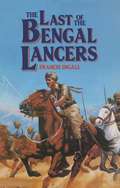- Table View
- List View
The Last Train from Hiroshima: The Survivors Look Back
by Charles PellegrinoDrawing on the voices of atomic bomb survivors and the new science of forensic archaeology, Charles Pellegrino describes the events and aftermath of two days in August when nuclear devices detonated over Japan changed life on earth forever. At the narrative's core are the eyewitness accounts of the people who experienced the effects of the atomic explosions firsthand. Thirty people are known to have fled Hiroshima for the imagined safety of Nagasaki--where they arrived just in time to survive yet another atomic bomb. Tsutomu Yamaguchi, who is still alive, is the only person known to have survived the full effects of the blast at Ground Zero both times. The second time, the blast effects were diverted around the stairwell of a building in which he had been standing, placing him and the small group of people standing with him in a shock cocoon, while the entire office building disappeared around them. Almost everything we know about the bombing turns out to be wrong. For all its fury the Hiroshima bomb had been compromised during a preflight test. Only hours before Enola Gay took off, on August 6, physicist Luis Alvarez juiced up the weakened bomb with three plugs of polonium and beryllium (the nuclear equivalent of inserting nitrous oxide into a race car's engine). A stunning "you are there" time capsule, The Last Train from Hiroshima is enriched by the author's scientific authority and close relationship with the bombs' survivors, making his account the most gripping ever written.
The Last Train: A Holocaust Story
by Rona AratoThe Last Train is the harrowing true story about young brothers Paul and Oscar Arato and their mother, Lenke, surviving the Nazi occupation during the final years of World War II. <p><p> Living in the town of Karcag, Hungary, the Aratos feel insulated from the war — even as it rages all around them. Hungary is allied with Germany to protect its citizens from invasion, but in 1944 Hitler breaks his promise to keep the Nazis out of Hungary. <p> The Nazi occupation forces the family into situations of growing panic and fear: first into a ghetto in their hometown; then a labor camp in Austria; and, finally, to the deadly Bergen Belsen camp deep in the heart of Germany. Separated from their father, 6-year-old Paul and 11-year-old Oscar must care for their increasingly sick mother, all while trying to maintain some semblance of normalcy amid the horrors of the camp.<p> In the spring of 1945, the boys see British planes flying over the camp, and a spark of hope that the war will soon end ignites. And then, they are forced onto a dark, stinking boxcar by the Nazi guards. After four days on the train, the boys are convinced they will be killed, but through a twist of fate, the train is discovered and liberated by a battalion of American soldiers marching through Germany. <p> The book concludes when Paul, now a grown man living in Canada, stumbles upon photographs on the internet of his train being liberated. After writing to the man who posted the pictures, Paul is presented with an opportunity to meet his rescuers at a reunion in New York — but first he must decide if he is prepared to reopen the wounds of his past.
The Last Treaty: Lausanne and the End of the First World War in the Middle East
by Michelle TusanIn The Last Treaty, Michelle Tusan profoundly reshapes the story of how the First World War ended in the Middle East. Tracing Europe's war with the Ottoman Empire through to the signing of Lausanne, which finally ended the war in 1923, she places the decisive Allied victory over Germany in 1918 in sharp relief against the unrelenting war in the East and reassesses the military operations, humanitarian activities and diplomatic dealings that continued after the signing of Versailles in 1919. She shows how, on the Middle Eastern Front, Britain and France directed Allied war strategy against a resurgent Ottoman Empire to sustain an imperial system that favored Europe's dominance within the nascent international system. The protracted nature of the conflict and ongoing humanitarian crisis proved devastating for the civilian populations caught in its wake and increasingly questioned old certainties about a European-led imperial order and humanitarian intervention. Its consequences would transform the postwar world.
The Last True Story I'll Ever Tell
by John CrawfordA young soldier's personal account of the United States' involvement in Iraq. John Crawford joined the Florida National Guard to pay for his college tuition-it had seemed a small sacrifice to give up one weekend a month and two weeks a year in exchange for a free education. But one semester short of graduating, and newly married, he was called to active duty-to serve in Kuwait, then on the front lines of the invasion of Iraq, and ultimately in Baghdad. While serving in Iraq, Crawford began writing short nonfiction stories, his account of what he and his fellow soldiers experienced in the war. At the urging of a journalist embedded with his unit, he began sending his pieces out of the country via an anonymous Internet e-mail account.
The Last Tsar: The Abdication of Nicholas II and the Fall of the Romanovs
by Tsuyoshi Hasegawa&“Elegantly written and magisterially researched&” (Robert Service, author of A History of Modern Russia), the definitive story behind the self-destruction of the autocratic Romanov dynasty, by the world&’s foremost expert When Tsar Nicholas II fell from power in 1917, Imperial Russia faced a series of overlapping crises, from war to social unrest. Though Nicholas&’s life is often described as tragic, it was not fate that doomed the Romanovs—it was poor leadership and a blinkered faith in autocracy. Based on a trove of new archival discoveries, The Last Tsar narrates how Nicholas&’s resistance to reform doomed the monarchy. Encompassing the captivating personalities of the era, it untangles the struggles between the increasingly isolated Nicholas and Alexandra and the factions of scheming nobles, ruthless legislators, and pragmatic generals who sought to stabilize the restive Russian empire either with the Tsar or without him. By rejecting compromise, Nicholas undermined his supporters at crucial moments. His blunders cleared the way for all-out civil war and the eventual rise of the Soviet Union. Definitive and engrossing, The Last Tsar uncovers how Nicholas II stumbled into revolution, taking his family, the Romanov dynasty, and the whole Russian Empire down with him.
The Last Tsar: The Abdication of Nicholas II and the Fall of the Romanovs
by Tsuyoshi HasegawaA HISTORY TODAY BOOK OF THE YEAR'Certain to become the definitive work' DOUGLAS SMITH'Elegantly written and magisterially researched' ROBERT SERVICE'Masterful . . . a chilling lesson' VLADISLAV ZUBOKThe definitive story behind the self-destruction of the autocratic Romanov dynasty, by the world's foremost expert.When Tsar Nicholas II fell from power in 1917, Imperial Russia faced a series of overlapping crises, from war to social unrest. Though Nicholas's life is often described as tragic, it was not fate that doomed the Romanovs - it was poor leadership and a blinkered faith in autocracy.Based on a trove of new archival discoveries, The Last Tsar narrates how Nicholas's resistance to reform doomed the monarchy. Encompassing the captivating personalities of the era, it untangles the struggles between the increasingly isolated Nicholas and Alexandra and the factions of scheming nobles, ruthless legislators, and pragmatic generals who sought to stabilize the restive Russian empire either with the Tsar or without him. By rejecting compromise, Nicholas undermined his supporters at crucial moments. His blunders cleared the way for all-out civil war and the eventual rise of the Soviet Union.Definitive and engrossing, The Last Tsar uncovers how Nicholas II stumbled into revolution, taking his family, the Romanov dynasty, and the whole Russian Empire down with him.
The Last Tsar: The Abdication of Nicholas II and the Fall of the Romanovs
by Tsuyoshi HasegawaA HISTORY TODAY BOOK OF THE YEAR'Certain to become the definitive work' DOUGLAS SMITH'Elegantly written and magisterially researched' ROBERT SERVICE'Masterful . . . a chilling lesson' VLADISLAV ZUBOKThe definitive story behind the self-destruction of the autocratic Romanov dynasty, by the world's foremost expert.When Tsar Nicholas II fell from power in 1917, Imperial Russia faced a series of overlapping crises, from war to social unrest. Though Nicholas's life is often described as tragic, it was not fate that doomed the Romanovs - it was poor leadership and a blinkered faith in autocracy.Based on a trove of new archival discoveries, The Last Tsar narrates how Nicholas's resistance to reform doomed the monarchy. Encompassing the captivating personalities of the era, it untangles the struggles between the increasingly isolated Nicholas and Alexandra and the factions of scheming nobles, ruthless legislators, and pragmatic generals who sought to stabilize the restive Russian empire either with the Tsar or without him. By rejecting compromise, Nicholas undermined his supporters at crucial moments. His blunders cleared the way for all-out civil war and the eventual rise of the Soviet Union.Definitive and engrossing, The Last Tsar uncovers how Nicholas II stumbled into revolution, taking his family, the Romanov dynasty, and the whole Russian Empire down with him.
The Last Valentine
by James Michael Pratt[from inside flaps] "The Last Valentine is a love story with the power to transcend time. Beginning with a wife's farewell to her husband in World War II and continuing to the present day, James Michael Pratt weaves a tale of love and faith and devotion that you will never forget. Television reporter Susan Allison is looking for the perfect story about true love, but her heart of hearts tells her such a thing doesn't really exist. Writer Neil Thomas, Jr., wants only to share the powerful message of the "last Valentine," his parents' tragic yet triumphant fifty-year love story. On February 14, 1944, Caroline Thomas said good-bye to her beloved husband, a Navy pilot sent to the Pacific. For fifty years, she waited for him to return--until a miracle happens and she receives his last Valentine. In the present day, when Susan and Neil meet, neither of them expects the emotional outcome: that the story of Neil's parents will bring them together in a love as powerful as she dreams of and he remembers."
The Last Valley: Dien Bien Phu and the French Defeat in Vietnam
by Martin WindrowStalingrad in the jungle: the battle that doomed the French Empire and led America into VietnamIn winter 1953-54 the French army in Vietnam challenged its elusive enemy, General Giap's Viet Minh, to pitched battle. Ten thousand French paras and légionnaires, with artillery and tanks, were flown to the remote valley of Dien Bien Phu to build a fortress upon which Giap could smash his inexperienced regiments. The siege which followed became a Stalingrad in the jungle, and its outcome shocked the world.
The Last Valley: Dien Bien Phu and the French Defeat in Vietnam
by Martin WindrowStalingrad in the jungle: the battle that doomed the French Empire and led America into VietnamIn winter 1953-54 the French army in Vietnam challenged its elusive enemy, General Giap's Viet Minh, to pitched battle. Ten thousand French paras and légionnaires, with artillery and tanks, were flown to the remote valley of Dien Bien Phu to build a fortress upon which Giap could smash his inexperienced regiments. The siege which followed became a Stalingrad in the jungle, and its outcome shocked the world.
The Last Vermeer: Unvarnishing the Legend of Master Forger Han van Meegeren
by Jonathan Lopez“A grand yarn of twisty deceit, involving prestigious dupes and scads of money, with a sensational trial at the finish.” —The New YorkerIt’s a story that made Dutch painter Han van Meegeren world-famous when it broke at the end of World War II: A lifetime of disappointment drove him to forge Vermeers, one of which he sold to Hermann Goering in mockery of the Nazis. And it’s a story that’s been believed ever since. Too bad it isn't true.Jonathan Lopez has drawn on never-before-seen documents from dozens of archives for this long-overdue unvarnishing of Van Meegeren’s legend. Neither unappreciated artist nor antifascist hero, Van Meegeren emerges as an ingenious, dyed-in-the-wool crook. Lopez explores a network of illicit commerce that operated across Europe: Not only was Van Meegeren a key player in that high-stakes game in the 1920s and ’30s, landing fakes with famous collectors such as Andrew Mellon, but he and his associates later cashed in on the Nazi occupation.Nominated for an Edgar Award and made into a film starring Guy Pearce, The Last Vermeer is a revelatory biography of the world’s most famous forger—a talented Mr. Ripley armed with a paintbrush—and a deliciously detailed story of deceit in the art world.Includes photographs“His pioneering research on van Meegeren’s early life gives us further insight into what motivates deception, a subject that will never cease to fascinate as long as art is bought and sold.” —ARTNews“Brings hard light to van Meegeren’s machinations and (very bad) character.” —The New Yorker“Fascinating . . . Lopez’s writing is witty, crisp and vigorous, his research scrupulous and his pacing dynamic.” —Publishers Weekly (starred review)“A terrific read.” —Houston Chronicle“It’s hard to imagine improving on Lopez’s gem of a tale.” —Los Angeles TimesPreviously published as The Man Who Made Vermeers
The Last Voice: Roy J. Glauber and the Dawn of the Atomic Age
by José Ignacio Latorre María Teresa Soto-SanfielMost human beings don’t manage to achieve fame. Roy J. Glauber did so for two different reasons. Glauber was not only a Nobel-Prize winning physicist, but also one of the last surviving scientists who worked in Los Alamos in the Theoretical Division of the Manhattan Project. He was a witness to all the events and knew all the scientists associated with the creation and launch of the first atomic bombs. This book is the product of a series of long interviews held with Roy over three years: in Benasque (Spain) in 2011, and later in Singapore and Cambridge (USA). Its pages give a first-hand account of a true protagonist, one who is independent, lucid, sagacious and committed to the truth. The authors have respectfully preserved his spirit: his voice is the one that matters. The authors asked the questions and they relay his answers. Their comments are confined to the footnotes and to brief explanatory paragraphs, added simply to provide certain relevant details. The importance of the events that Glauber describes here is indisputable, as therefore is the book itself. The events narrated in its pages will remain part of world history, perhaps for centuries or even millennia. We live today in the shadow of the decisions made at that time.
The Last War Dance (Destroyer #17)
by Warren Murphy Richard SapirRemo and Chiun on the warpath against a tribe of blackmailing Indians! A Blast From The Past Well, nearly. The eyes of the world are on Wounded Elk when that small Midwestern town finds it has been captured by rampaging Indians who intend to even the score against the paleface. And what no one - except CURE - knows yet is that just outside the city limits is the United States' biggest and most secret nuclear installation, loaded with enough atomic weapons to blow our galaxy into the next millennium. CURE, America's most secret government agency - received an urgent call from a nervous White House caller. Remo and Chiun are needed. It's up to them to make sure that no one tampers with the doomsday stockpile - or tries to blackmail the U.S. with its own atom bombs. The rights of American Indians? That's a whole 'nuther thing.
The Last War: A Novel
by Ana Menéndez"Exquisitely crafted. . . strikingly real and heartfelt." —Denver Post“[A] potent literary novel . . . A deft portrait of an estranged couple whose pain is veiled by the fog of war.” —PeopleA breathtaking novel of love, war, and betrayal from the critically acclaimed author of Loving Che and the New York Times Notable Book, In Cuba I Was a German Shepherd. From the battlefields of Afghanistan and Iraq to the strange, shimmering streets of Istanbul, The Last War is a “seductive meditation” (O, The Oprah Magazine) on cruelty and violence, love and identity from Pushcart Prize-winning author Ana Menéndez.
The Last Warlord: The Life and Legend of Dostum, the Afghan Warrior Who Led US Special Forces to Topple the Taliban Re
by Brian WilliamsChronicling the spectacular rise to power of General Abdul Rashid Dostum, this is an intimate profile of the one of the most powerful warlords to have dominated Afghanistan in the years since the Soviet withdrawal in the late 1980s. His rise from simple peasant villager to warrior against the repressive policies of the Taliban and Al Qaeda is told by one of the few outsiders to be accepted into Dostum's stronghold in the northern deserts of Afghanistan. Thanks to this unprecedented access, author Brian Glyn Williams was able to conduct lengthy interviews with Dostum and his family, as well as his subcommanders, local chieftains, mullahs, Taliban enemies, prisoners of war, and women's rights activists. What emerges is an intensely personal account of the Mongol warlord, detailing his childhood, motivations, hopes for his country, and conviction that it is time for a new generation of Western-trained technocrats to shape his country's destiny. With the drawing down of U.S. troops in 2014 and Dostum poised to reenter the world stage to fight a resurgent Taliban, this timely analysis provides important historical context to the controversy swirling around Afghanistan's warlord culture and is an essential contribution to the debate on Afghanistan's future.
The Last Will and Testament of Alexander the Great: The Truth Behind the Death that Changed the Graeco-Persian World Forever
by David GrantA re-assessment of Alexander the Great's death, exposing a conspiracy by Alexander's generals after his death to undermine his empire.Alexander the Great conquered the largest empire the world had ever seen while still in his twenties but fell fatally ill in Babylon before reaching 33 years old. His wife Roxanne was still pregnant with what would be his only legitimate son, so there was no clear-cut heir. The surviving accounts of his dying days differ on crucial detail, with the most popular version claiming Alexander uttered ‘to the strongest’ when asked to nominate a successor on his deathbed. Decades of ‘civil war’ ensued as Alexander’s hard-won empire was torn asunder by generals in the bloody ‘funeral games’ his alleged final words heralded in. The fighting for supremacy inevitably led to the extermination of his bloodline. But was Alexander really so short-sighted and irresponsible? Finally, after 2,340 years, the mystery is unravelled. In a forensic first, David Grant presents a compelling case for what he terms the ‘greatest succession cover up of all time’. Alexander’s lost Last Will and Testament is given new credibility and Grant deciphers events that led to its erasure from history by the generals who wanted to carve up the empire for themselves.
The Last Year of the German Army: May 1944 - May 1945
by James LucasThe year the once all-conquering German army was finally defeated. By the summer of 1944, Germany was in crisis. The Allied landings had forced another battle arena upon an army already fighting on the vast Eastern front. The July bomb plot attempt on Hitler’s life made the dictator even more paranoid and suspicious of his own military commanders. In this absorbing study, James Lucas examines the army’s changing structure and weaponry throughout this final year of war, and reveals the often surprising measures taken to confront a situation Hitler had never contemplated, and never really accepted. From D-Day to the Battle of the Bulge and on to the Fall of Berlin, the author examines the last battles fought by the German army – which had by no means given up its struggle – as the Allies swept across Europe, charting the very unique experiences of a military force moving from dominance to defeat. Perfect for readers of Antony Beevor and Max Hastings.
The Last Year of the Luftwaffe: May 1944 to May 1945 (Military Ser.)
by Alfred PriceA historian analyzes Nazi Germany&’s air force during its final year before Allied forces brought an end to World War II in Europe.The Last Year of the Luftwaffe is the story of a once all-conquering force struggling to stave off an inevitable and total defeat. This book gives a complete account of Luftwaffe operations during the last twelve months of the fighting in Europe—including the dramatic Bodenplatte (or &“Baseplate&”) offensive over the Ardennes in December, 1944. In this comprehensive examination of Hitler&’s air force, Dr. Alfred Price examines its state from May, 1944, to May, 1945, analyzing not only the forces available to it, but also the likely potential, and impact, of new aircraft and weapons systems. He also assesses the Luftwaffe&’s High Command&’s performance and the effect of Allied attacks and operations. In doing so he rejects several long-standing myths, clarifies the impact of the jet and rocket fighters, and demonstrates that the Luftwaffe performed as well as could be expected under the harsh circumstances of fighting a losing war.
The Last Year of the War
by Susan MeissnerFrom the acclaimed author of Secrets of a Charmed Life and As Bright as Heaven comes a novel about a German American teenager whose life changes forever when her immigrant family is sent to an internment camp during World War II. Elise Sontag is a typical Iowa fourteen-year-old in 1943—aware of the war but distanced from its reach. Then her father, a legal U.S. resident for nearly two decades, is suddenly arrested on suspicion of being a Nazi sympathizer. The family is sent to an internment camp in Texas, where, behind the armed guards and barbed wire, Elise feels stripped of everything beloved and familiar, including her own identity. The only thing that makes the camp bearable is meeting fellow internee Mariko Inoue, a Japanese-American teen from Los Angeles, whose friendship empowers Elise to believe the life she knew before the war will again be hers. Together in the desert wilderness, Elise and Mariko hold tight the dream of being young American women with a future beyond the fences. But when the Sontag family is exchanged for American prisoners behind enemy lines in Germany, Elise will face head-on the person the war desires to make of her. In that devastating crucible she must discover if she has the will to rise above prejudice and hatred and re-claim her own destiny, or disappear into the image others have cast upon her. The Last Year of the War tells a little-known story of World War II with great resonance for our own times and challenges the very notion of who we are when who we’ve always been is called into question.
The Last Years of Robert E. Lee: From Gettysburg to Lexington
by Douglas SavageThis book details Lee&’s life from Gettysburg to his death just five years after the South&’s surrender at Appomattox. Rather than retreating bitterly from life, Lee sought to heal the nation, even meeting with his rival, Ulysses S. Grant, while the former Union general occupied the White House. Leaving his military life behind, Lee went on to become president of Washington College, where he was revered for his fairness as well as his willingness to help struggling students.
The Last Years of the Teutonic Knights: Lithuania, Poland and the Teutonic Order
by William Urban“The most comprehensive account available of the final years of the crusading military order” from the acclaimed author of Medieval Mercenaries (Baltische Historiche Kommission).The Battle of Grunwald was one of the largest battles in Medieval Europe and was the most important in the histories of Poland and Lithuania.It was fought on 15 July 1410 during the Polish-Lithuania-Teutonic War between the alliance of the Kingdom of Poland (led by King Jagiello) and the Grand Duchy of Lithuania (led by Grand Duke Vytautas) against the German-Prussian Teutonic Knights (led by Grand Master Ulrich von Jungingen) and with the assistance of Sigismund, then King of Hungary and Croatia.The Teutonic Knights, a crusading military order, were defeated and most of their leaders were killed or taken prisoner. This defeat would mark the beginning of their decline and they would never again regain their former power.Following the battle, the balance of power shifted in Central and Eastern Europe and so came the rise of the Polish-Lithuanian union as the dominant political and military force.In this compelling account the action takes place in Lithuania, Poland, the Czech Republic, Hungary, Russia and Germany. There are bloody battles; fascinating characters; intrigue; betrayals; sex; unexpected twists of fate; religious heresy and a smattering of saints. There is also the monumental end of one era making way for the beginning of another.While there has long been interest on the crusades outside of the Holy Land, this book is unique in the sheer breadth and depth of its research.“A must-read for those seeking scholarly work on this pivotal period of European history.” —Journal of Military History
The Last of Africa's Cold War Conflicts: Portuguese Guinea and its Guerilla Insurgency
by Al J. VenterThis detailed combat history sheds light on the significant yet overlooked guerilla campaigns in what would become Angola and Guinea-Bissou.Portugal was the first European country to colonize Africa. It was also the last to leave, almost five centuries later. During what Lisbon called its “civilizing mission” the Portuguese weathered numerous insurrections, but none as severe as the guerrilla war first launched in Angola in 1961 and two years later in Portuguese Guinea. Both the Soviets and the Cubans believed that because the tiny colony of Guinea had no resources, Lisbon would soon capitulate. But the 11-year struggle became the empire’s most strenuous attempt to retain colonial power. Though it was overshadowed by the conflict in Vietnam, the Soviet-led guerrilla campaign in Portuguese Guinea set the scene for the wars that followed in Rhodesia and present-day Namibia.
The Last of the 357th Infantry: Harold Frank's WWII Story of Faith and Courage
by Mark HagerFor those who loved Stephen E. Ambrose's Band of Brothers and E.B. Sledge's With the Old Breed. Drawing on toughness and skills forged in hardscrabble Depression-era North Carolina, Bronze Star recipient and expert B.A.R. rifleman Harold Frank invades Normandy, fights Germans, and endures a grueling stint in a German POW camp where he witnesses the fire-bombing of Dresden.From D-Day to Dresden with a Crack Shot B.A.R. Rifleman D-Day 1944: twenty-year-old PFC Harold Frank had moved as one with his battalion onto the shores of Utah Beach, pushing into France to cut off and blockade the pivotal Nazi-occupied deep-water port of Cherbourg. As a recognized crack shot with WW II's iconic American automatic rifle, Frank fought bravely across the bloody hedgerows of the Cotentin Peninsula. During the most intense fighting, Frank was ambushed and wounded in a deadly, nine-hour firefight with Germans. Taken prisoner and with a bullet lodged under one arm, Frank found himself dumped first in a brutal Nazi POW concentration camp, then shipped to a grueling work camp on the outskirts of Dresden, Germany, where the young PFC was exposed to the vengeance of a crumbling Nazi regime, the menace of a rapidly advancing Russian military—and the danger of thousands of Allied bombers screaming overhead during the firebombing of Dresden. Historian Mark Hager builds on hundreds of hours of interviews with Harold Frank, sharing the intimate and heart-pounding account of Frank&’s journey as a child of the Great Depression to the bloody shores of the D-Day invasion, into the bowels of Nazi Germany, and back to the U.S. where as a young man Harold would spend years resolutely dealing with the lingering effects of starvation rations while determinedly building a new life—a life always mindful of the legacy of his POW experience and his faithful service in America&’s hard-fought war against Nazi aggression.
The Last of the 39-ers: The Extraordinary Wartime Experiences of Squadron Leader Alfie Fripp
by Sean FeastThe story of the RAF pilot and POW shot down in 1939—including his role in the Great Escape from Stalag Luft III—is told in this intimate WWII biography. While on a reconnaissance sortie over Germany in 1939, Royal Air Force Flight Lieutenant Alfie Fripp was shot down by the Luftwaffe and taken prisoner. The longest-serving British prisoner of war, he was also the last of the surviving &“39-ers&” when he died in 2012. His wartime years were spent in numerous camps, including the infamous Stalag Luft III, where he took an active role in the prison break immortalized by the film The Great Escape. Fripp also served during the interwar period and returned to service after being released in 1945. Before he died, Fripp, began working with aviation historian Sean Feast on his memoirs. Feast has now combined copious research with Fripp&’s candid account and personal photographs to produce this lively and authoritative biography.
The Last of the Bengal Lancers
by Francis IngallOne of the last of the famed Bengal Lancers, Brigadier Ingall has spent most of his life in India and Pakistan. When he first went to India in 1929, all the officers were English and all the enlisted men were Indian (Hindu, Sikh and Moslem). India was part of theBritish Empire and the Army was basically involved with hunting down outlaw bands of horsemen and keeping them in order. One of his first experiences there was leading a charge on horseback (swords in hand) of the 5th D.C.O. Lancers in the battle of karawal near the Khyber Pass. Later, in the Second World War, he commanded the 6th Lancers in a drive through northern Italy. By this time he had traded their horses for light armour (manufactured by General Motors), but the hazards were no less great. In one 2-hour punch, Ingall's forces cut a swathe through the remnants of the three German Divisions and penetrated 50 miles into enemy territory. For this he won the DSO. He was also awarded an OBE by King George VI for his service as founder and head of the Pakistan Military Academy which he was invited to found by no less person then Mohammad Ali Jinnah himself. Ingall serves as the academy's Commandment until 1951. Since then he has revisited the area several times as an honoured guest of the state, In 1982 he was appointed Honorary Council General of Pakistan , in California, where he now lives, by it's president General Zia-ul-Haq , who described Ingall as 'one of the founding fathers or our army.' During his many years in India and Pakistan he knew and worked with with the areas most important dignitaries such as Lord Mountbatten and Lord Ismay, Gandhi and Nehru. This is an autobiography full of incident and humour which will delight not only the old and bold but but all those who enjoy reading about the last days of the Raj.
